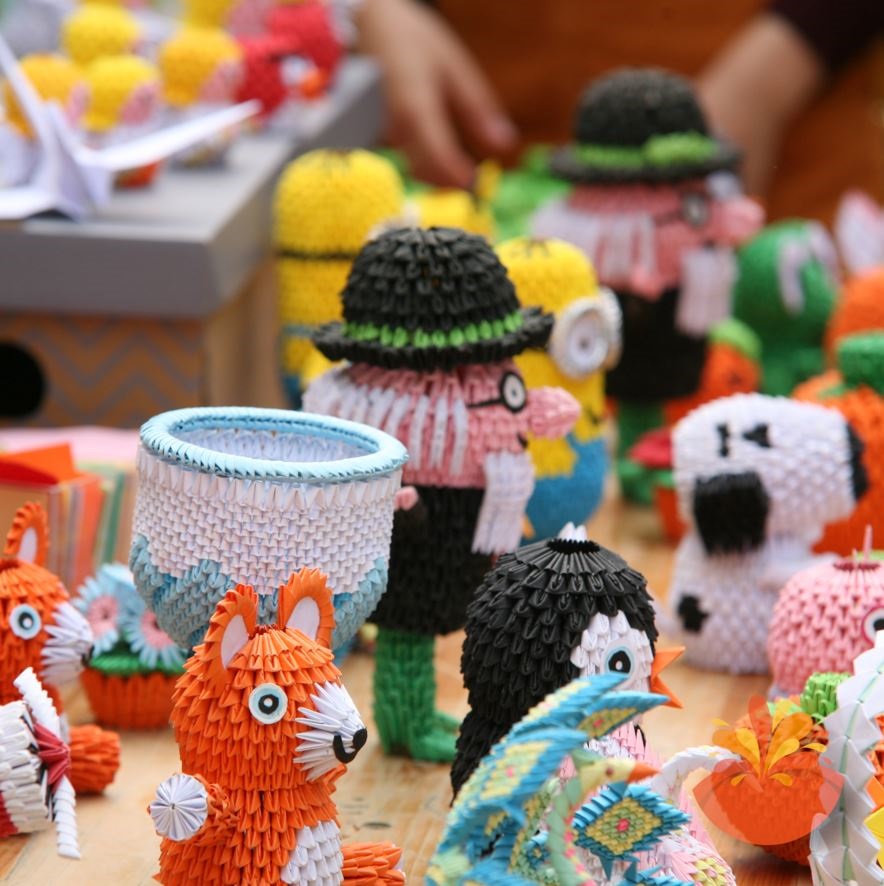Drones Plant Self-Germinating Tree Seed Packets in Grubisno Polje
September the 28th, 2021 - World Ozone Day is celebrated on September the 16th every year, and something very interesting took place in Croatia when a large action involving the afforestation of Grubisno Polje happened with the help of a drone.
As Poslovni Dnevnik/Lucija Spiljak writes, what took place at Grubisno Polje is the Croatian O2 Project, the first afforestation campaign in Croatia to be carried out in this brand new and modern way using the product Seed Bombs, which are self-germinating packets of tree seeds.
The founders of the Croatian O2 project, Dusan Jelic and Goran Ladisic jointly devised natural and ecological solutions for growing young shoots and afforestation, which will reduce excessive emissions of carbon dioxide (CO2) responsible for climate change. They explained in more detail what exactly the Seed Bombs product represents.
“In Seed Bombs, in addition to the primary seed of the trees, there are also seeds of accompanying plant species. It isn't enough to simply plant a certain number of large trees for successful afforestation. Such a principle leads to the development of the culture of that type of tree alone, and not the development of a healthy forest habitat (a healthy ecosystem).
Furthermore, a large amount of CO2 is absorbed not only by trees but also by other parts of a healthy ecosystem (soil, grass, shrubs). Therefore, we define the afforestation's success according to the number of m2 of the restored ecosystem, and not one tree. The O2 project brings innovations in the field of biotechnology and the forestry sector, through the development of the first autonomous fleet of drones for rapid afforestation and the restoration of forest ecosystems. An innovative and patented formula for the production of protective seed bombs guarantees the high efficiency of seedling germination from seed material, and supports their rapid development in their first years of life,'' explained Goran Ladisic from the O2 Project.
The afforestation initiative at Grubisno Polje was joined by students from the Ivan Nepomuk Jemersic Elementary School which is close to the area, supported by Mayor Zlatko Madjeruh, residents of Grubisno Polje, as well as journalists and volunteers. The whole afforestation action took place with the help of Milan Domazet and Ivan Vidakovic from the company AIR RMLD, whose drone was used for afforestation, while Ljubomir Lokin from 3D Tech made the seed thrower.
The initiative was also supported by the insurance company Grawe, whose numerous employees participated in the project.
The President of the Management Board of Grawe, Natasa Kapetanovic, pointed out that the project wanted to emphasise the importance of applying a scientific approach in initiatives to preserve our planet.
''The scientific principles of the O2 Project have shown us that there's really a big difference between the spontaneous planting of trees and complete afforestation. With a comprehensive approach to afforestation using technological innovations, the O2 Project can further educate us about the important facts of reducing the carbon footprint and new principles of better construction and the preservation of a healthy ecosystem,'' said Kapetanovic.
For more, follow our dedicated lifestyle section.
E-Commerce Sees Croatian Modepack's Business Excel, Investments Coming
September the 28th, 2021 - The Croatian Modepack company has a lot to thank e-commerce for, which rose in popularity in Croatia during the coronavirus pandemic. Investments are on the cards as business excels for this Zagreb-based enterprise.
As Poslovni Dnevnik/Darko Bicak writes, the likes of Amazon, H&M, Vans, Adidas, DHL, DPD, Loomis, and numerous European financial institutions as well as the diamond exchange in Antwerp (Antwerpen World Diamond Centre) are just some of the many users of courier and security packaging of the Croatian Modepack company.
Although it has only been on the market for five years, Modepack is already one of the global leaders in the production of high-quality packaging for the logistics transport of goods, with an emphasis placed on e-commerce, courier deliveries and security packaging for money and valuables. They export to 32 world markets, with a total share of exports in business of over 90 percent. As Jure Siric, the director and owner of the company, explains, the Croatian Modepack company was based on the previous assessment that e-commerce would soon become a reality, and this happened long before he himself had hoped.
“I'm not a complete foreigner in this industry because I come from the family company Weltplast, which has been dealing with packaging and recycling since back in 1983, and since 2010 I've been leading sales for EU markets in it. But... that's a big company that deals with packaging and raw materials in general, and my desire was to step into something new and different. Apparently, I wasn't wrong in making that move,'' said Siric.
He added that the global coronavirus pandemic, although it halted the entire society and economy over the past year, has led to enormous growth in the e-commerce segment that has surprised them as well. Due to the exponential growth of the business, the Croatian Modepack company decided to embark on a new investment and to go for double capacities in 2020. In one month, construction work should begin on their new plant in Velika Gorica which will total at a massive 50 million kuna. The plant will be in the immediate vicinity of their important customer, Croatian Post (Hrvatska posta) which has its own logistics and distribution centre located there.
The project, which should be completed by the summer of 2022, was also helped by the EU with handsome funds in the amount of 7.5 million kuna.
"We're currently working on five production lines, which is actually insufficient for us. In addition to moving the existing ones, we're going to install three new production lines in the new plant, which will have the same capacity as these five put together, but will have much greater technological possibilities, especially in terms of paper packaging, which is increasingly in demand due to trends,'' said Siric. Of the total investment, more than two thirds of it will be invested into equipping the plant's production, while the rest will go to construction works.
The new plant will employ about 20 new workers, which will mean an employment growth of about 50 percent, given that they currently have 42 employees. The director of this company explained that the new plant will have a capacity of 12 to 14 production lines, if market conditions require it, and about 80 employees.
"As ecology and the green agenda are generally a very important topic in our business, we've even decided to apply this model when planning investments. To be more specific, we decided not to go into a greenfield investment, but to recycle an existing facility. We soon found what we were looking for in the unfinished project of the failed construction company Tempo, which started building its sales headquarters in Velika Gorica back in the mid-1990s, but due to business difficulties ,the project was halted and the company ended up going bankrupt,'' explained Siric.
As it is a large area, a building of 5500 m2 and land covering 32,000 square metres in total, further expansion is possible. Flying on the wings of e-commerce and volume growth, the Croatian Modepack company has been recording constant growth in terms of revenue that amounted to 50 million kuna last year, which represented growth of 60 percent when compared to the year before when they grew by 30 percent, while this year they expect additional growth of 20 percent and revenue of about 60 million kuna. With this new plant and the expansion of their range, they expect that in 2025, their revenue should reach the 150 million kuna mark, if not more.
“Global e-commerce is growing unstoppably, and even before the coronavirus pandemic, during 2019, global growth stood at 21 percent. Data for last year shows that countries with more developed e-commerce achieved significant, but still lower growth, while countries like Croatia measured growth in literal hundreds of percentage points. The statistics at our disposal show that e-commerce at the EU level increased by 31 percent last year, and if we look at some of the most important member states, then we can see that in Germany it is 22 percent, in the United Kingdom 31 percent, and in Spain 75 percent. Estimates for Croatia are over 200 percent,'' stated Jure Siric.
The Croatian Modepack company otherwise truly represents the pinnacle of technology in its sector and exports as much as 92 percent of its production.
For more, follow our business section.
Gligora Cheese Factory Wins 5 Awards at 2021 Great Taste Awards in UK
September 28, 2021 - Five Gligora Cheese Factory cheeses took home an award at the Great Taste Awards held this year!
It's likely that if you've been lucky enough to taste cheese in Croatia, chances are, it's from Gligora. With a history that dates back to 1918 when Ivan Gligora's grandfather began producing Pag cheese in Kolan on the island of Pag, the Gligora Dairy brand was soon born, and its success - inevitable.
Over the years, the Gligora brand has grown as home to Croatia's most prized dairy products. With over 50 employees at work every day, the factory produces over 450 tons of various cheeses annually, including about 50 tons of Pag cheese, with milk to make Pag cheese purchased from 200 partners from Pag, Dalmatia, Lika, and Kordun (for other cheese types).
International awards crown every year of work.
This time, the extra old Pag cheese, Likotin ripened in cherry Maraska, and Kozlar from olive pomace were awarded two stars, and Pag cheese and Težački cheese from wine must with one star at the 2021 Great Taste Awards in the UK!
The UK's annual Guild of Fine Food competition judged more than 14,000 entries, 355 judges took part, and less than 2 percent of them received the best three-star rating. Two-star awards were also given to 1,138 products, and 4,027 received a one-star rating.
"Attractive, aged cheese with a good contrast of crust and cheese dough. A well-groomed cheese manifests itself in nutty, sweet, sour, and caramel flavors that lead to the pleasant acidity typical of sheep cheese of this age. The cheese we want to eat!" said one of the judges about the extra old Pag cheese.
Šime Gligora, the owner of the Gligora cheese factory, was also pleased:
“We are very pleased with the awards as a confirmation of the effort, dedication, and quality of work of all employees of the cheese factory. This is a common success for all of us and an additional impulse for the future. I want to thank all the customers who have recognized our quality before these awards and regularly trust us with their purchases."
The Great Taste Awards were born in 1994 under the Guild of Fine Food Retailers with one goal - to ensure "retailers and producers work together to convince consumers that high quality, great-tasting food is mostly prepared in small batches by dedicated makers using fresh, honest & where possible local ingredients."
For more on lifestyle in Croatia, follow TCN's dedicated page.
Iovia Archaeological Park in Ludbreg: Retracing Roman, Pre-Historic Heritage
September 27, 2021 - The rich heritage of continuous habitation in continental Croatia dating back to the pre-Roman era is documented in the new Iovia Archaeological Park in Ludbreg.
One of the surprising discoveries in the fascinating world of continental Croatian tourism a few years ago was finding out that the oldest continuously inhabited town in Europe was located there. I must confess that when I heard this, I was very surprised - even more so when I had never actually heard of the town. It was just one of the many interesting things you can learn about Vinkovci: 10 Things to Know about Europe's Oldest Town.
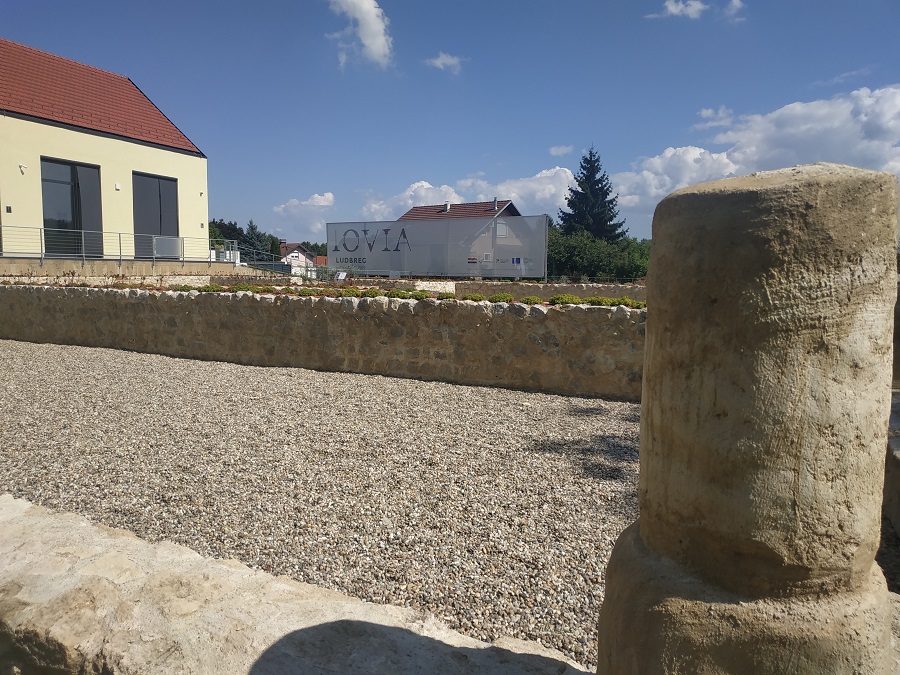
Visitors to the Adriatic coast will be familiar with the rich Roman history, with fabulous examples of its glorious past to be found in UNESCO World Heritage Site, Diocletian's Palace in Split, the Pula Area, and ancient Salona in Solin. Lesser known is the rich Roman history further inland in Croatia.
An important addition to preserving this heritage opened in June this year, in the form of the Iovia Archaeological Park in Ludbreg. Opened in June this year by the Minister of Culture and located on Ludbreg's main square, which is famous for its claim to be the centre of the world, the Iovia Archaeological Park provides a timeline with artifacts of the history of Ludbreg, Croatia, and the world through a variety of multimedia tools.
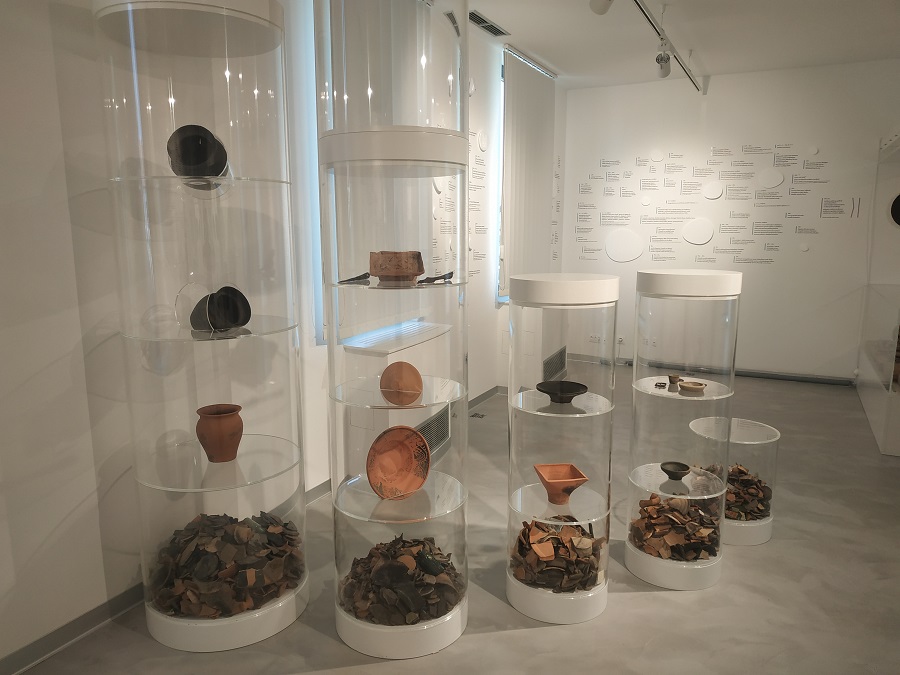
The timeline, which takes visitors through the important points of Ludbreg's long history, starts back in 20,000 BC, with the discovery of Erica, the most extensive and best-preserved Pleistocene woolly rhinoceros (Coelodonta antiquitatis) in Croatia. Erica was found in Mali Sigecak near Ludbreg in 1982.
Archaeological research in Ludbreg started in earnest some time before Erica's discovery, back in 1966. These continued from 1968 to 1979 and were conducted by the Archaeological Museum in Zagreb. And it appeared that Ludbreg had quite a history. Far from being a modern town, evidence of continuous living dating back over two millennia was unearthed.
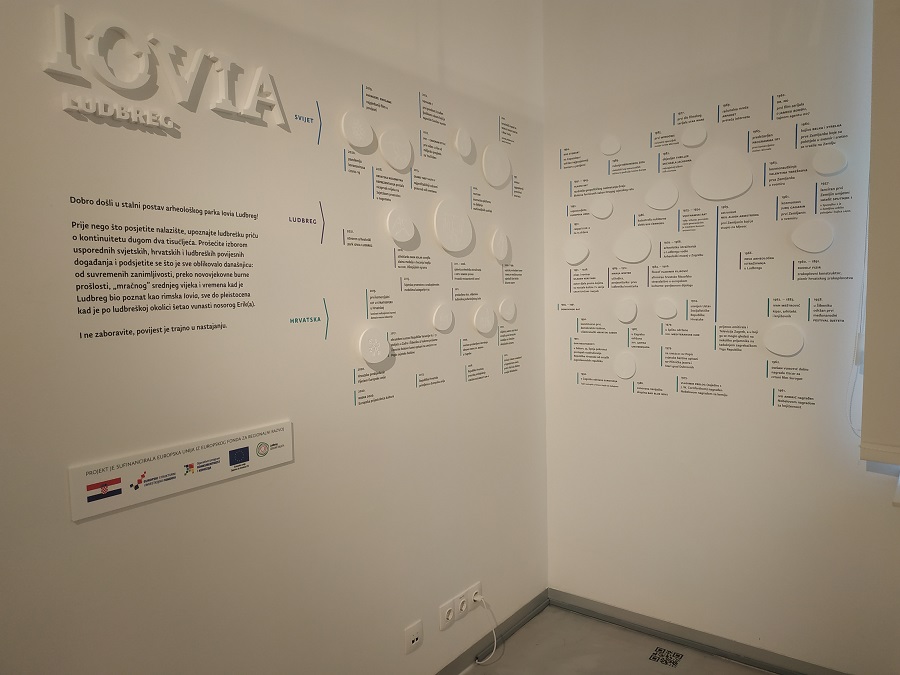
While the Roman era is perhaps the best-preserved, evidence of pre-historic sites from the first century BC to 4,000 BC were found in the wider Ludbreg area: Donji Martijanec, Globočec, Jalžabet, Ludbreg, Ludbreg - Katalena, Ludbreški Ivanac, Martijanec, Sigetec Ludbreški, Struga, Sveti Đurđ, Sveti Petar Ludbreški, Veliki Bukovec, and Vrbanovec.
The Roman settlement of Iovia, the forerunner of Ludbreg, was founded probably sometime after the end of the first century AD. In 1931, iron and bronze decorative parts of a Roman chariot dating back to the 2nd century AD were found in a tumulus, almost certainly the work of a Pannonian workshop.
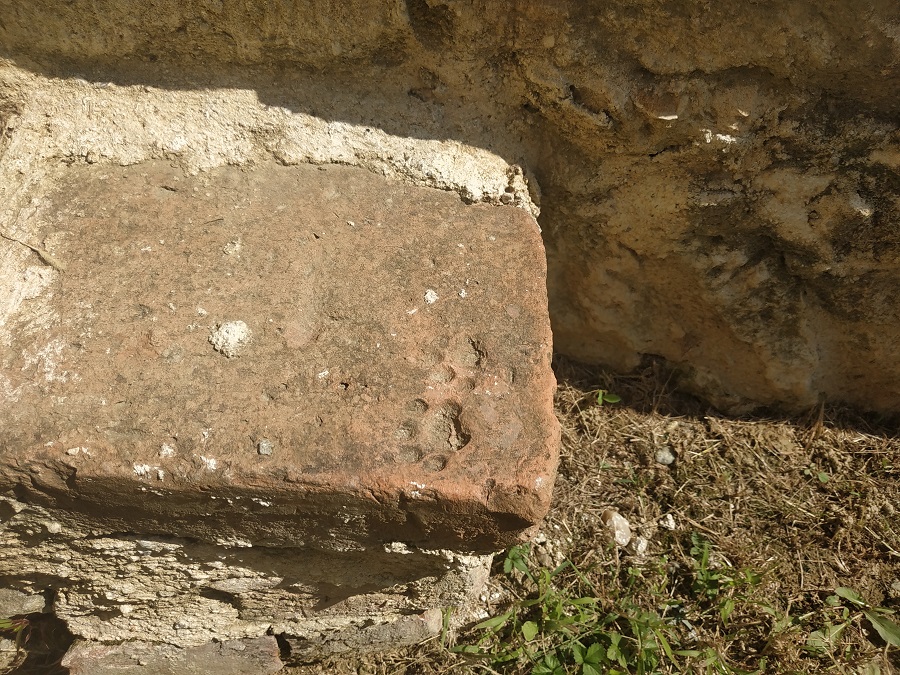
(A Roman cat leaves its mark in footprints)
The earliest archaeological finds dated Roman influence to the 2nd and 3rd centuries AD. The first known Roman find was back in 1859, a fragment with an inscription VALERIANVS CENTVRIO LEGIAE HIC IN LOCO IOVIA DICTO. This was followed in 1906 by part of a large bronze statue of a Roman Emperor. Then in 1942, a fragment of an altar with an inscription DEO SILVANO and IOVIA, the only preserved epigraphic confirmation of Iovia from Ludbreg.
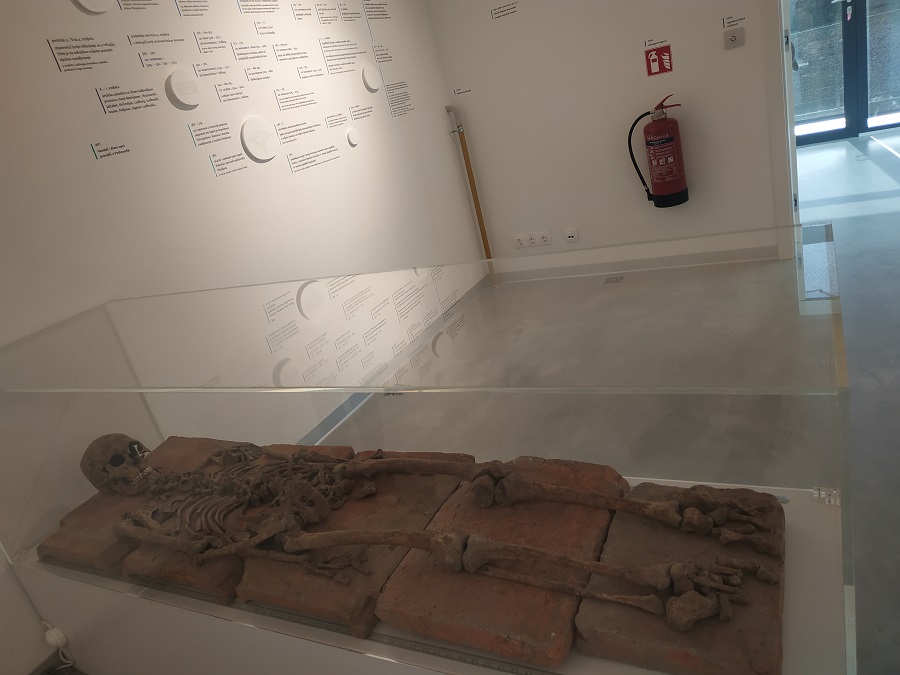
The biggest exhibit in the main building has been dated to around 420 AD. This is the skeleton of a man (about 55 years old) with neurosurgical intervention (trepanation) on the left side of the skull. He was buried with one silver buckle ring in a tomb made out of tegulae located in an adjacent Roman building.
From 2008 to 2011, the Croatian Restoration Institute conducted systematic archaeological research in the center of the town of Ludbreg ("Vrt Somođi"). During these works, the Roman building 1 (total gross area 230 m²) and most of the Roman building 2 (assumed gross area around 1780 m²) were fully explored. The excavated footprints of these buildings now constitute the external part of Iovia Archaeological Park behind the exhibition building.

The Iovia bathing house (Roman object 1) typologically belongs to the group of smaller baths (balneae), while according to the organization of space it belongs to the group of undiluted baths. Due to the spatial relationship with the neighbouring Roman facility, it can be defined as private. Such a form of bathing was widespread throughout the Roman Empire. The Iovia bathing house and the thermal springs in Varaždinske Toplice (Aquae Iasae) are the only fully explored facilities for this purpose in the Croatian part of the Roman province of Pannonia.
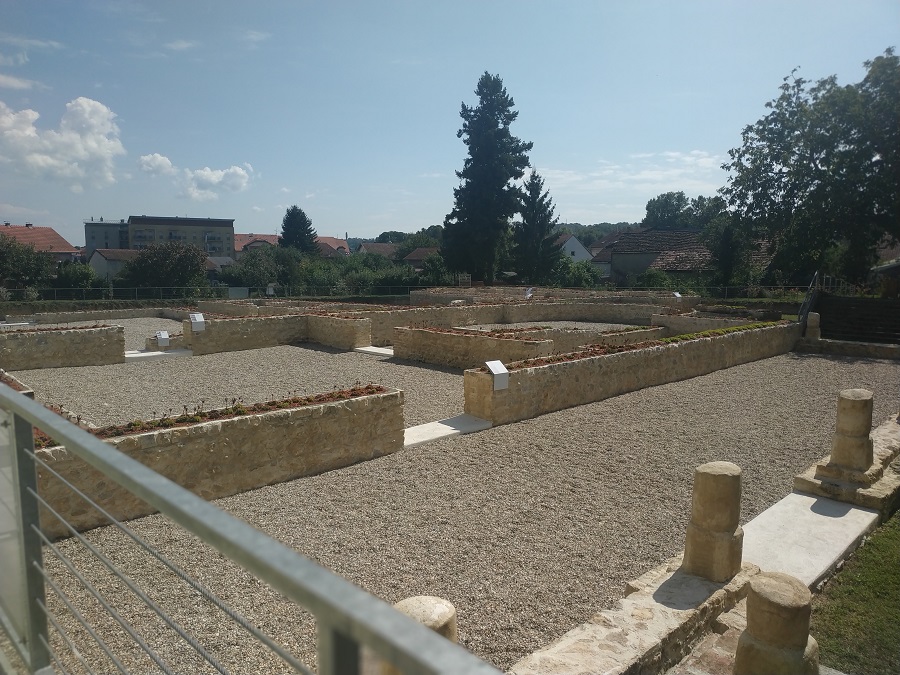
North of the baths, most of the Roman building 2 was explored, organized around a rectangular (uncovered) courtyard and defined on the west side by a porch. The building was built at the same time as the swimming pool, and was rebuilt and enlarged over the following centuries.
The two buildings were deemed to have been built during the second half of the 1st century and abandoned by 420 at the latest. They are typologically the most similar to the portico and peristyle type villas. This type was one of the most frequently used floor plan in the Pannonian, ie Danube - Balkan area.
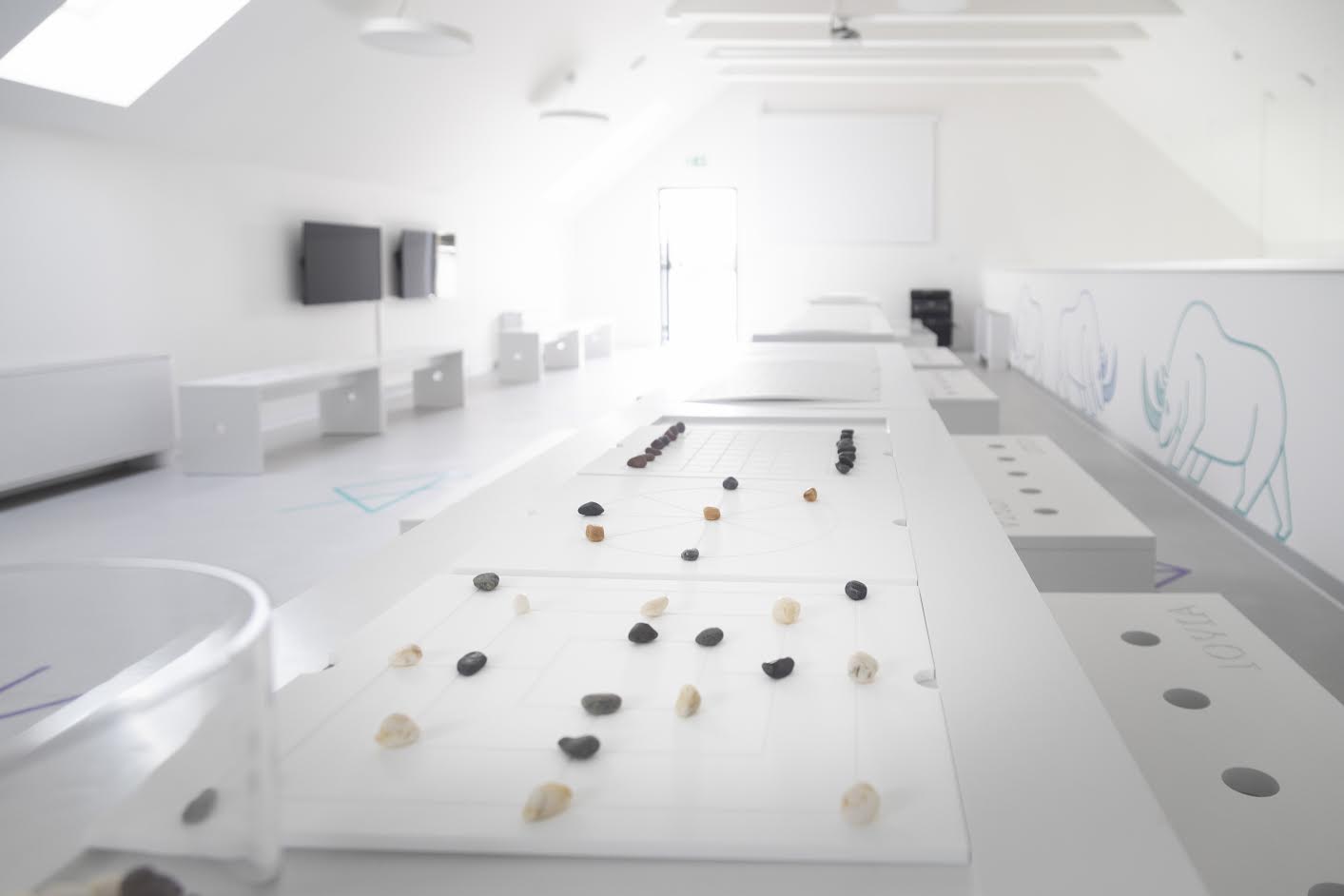
Iovia Archaeological Park is using different tools to bring to life the Roman and pre-historic past of the Ludbreg. One of the key target markets for Iovia is the younger generation, and many school trips are expected once the COVID-19 situation improves. The top floor is given over to a creative space for workshops, using various tools to bring to life a past era. Among these is the intriguing opportunity to learn how to play a variety of Roman board games. We will take a look at the Roman games on offer in Ludbreg - Latrunkuli, Terni Lapilli, and Mlin (Merellus) in a subsequent article.
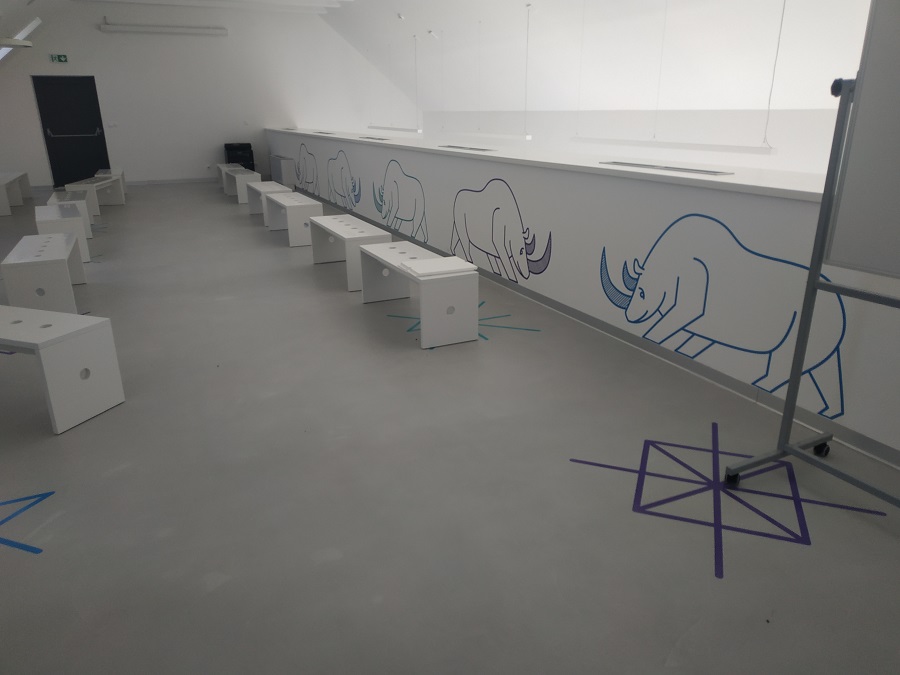
Tourism in continental Croatia is developing step by step. There is a huge story to be told of its rich heritage, and Iovia Archaeological Park is one more important step in the jigsaw. You can learn more about Iovia from the official website.
For the latest news from Ludbreg, follow the dedicated TCN section.
Honouring Ban Jelačić: Jelačić's Days in Zaprešić Coming in October
September 27, 2021 - In honour of Ban Jelačić, the Jelačić Days manifestation will present both this important protagonist from Croatian history as well as the town of Zaprešić.
Back during the times of the Austro-Hungarian Monarchy, the title of ''Ban'' was a noble title appointed by the monarch, and that person served as viceroy to the Croatian territory. Out of many people to earn the privilege, perhaps nobody is more known and loved by the Croats than Josip Jelačić.
This is particularly great for Zaprešić, a lovely town located (give or take) about 20 kilometres from Zagreb. The official day of Zapruđe is the same as Jelačić's birthday; October 16. In honour of both Zaprešić and the historic personality of Jelačić (who is buried in the town), Zapruđe is the host of Jelačić's Days.
''The central programme of this manifestation is the interactive play called ''A Moment of Memory with Ban''. The unique journey begins with the fun thematic Jelačić train that returns all visitors from the Zagreb Railway Station back to 1849 to the ranch of Ban Josip Jelačić,'' reads the Zaprešić Tourist Board website.
''The goal of Jelačić's Days manifestation is to tell the story of Ban Jelačić as one of the most important persons from Croatian history and revive the historical space of the New Jelačić Palace. With a rich cultural-educational-entertaining programme, we wish to attract as many tourists as possible to come and get better acquainted with Zaprešić,'' the Zaprešić Tourist Board site added.
The aforementioned New Jelačić Palace has been rated by the Zaprešić Tourist Board as a unique monument of cultural and historical heritage.
''Back in 1855, Ban Jelačić built the neo-Gothic chapel of St Joseph on a meadow next to the Palac, when, back in September of 1855, his nine-month-old daughter Ana suddenly died in Bohemia, her body was laid to rest in a vault inside the chapel. Later, the remains of Ban Jelačić (16th May 1859) and his brother Antun (1875) were buried inside the same chapel. When in 1991 works began on the restoration of the chapel, the remains were temporarily moved to Zagreb's famous Mirogoj, and in 1992 they were finally laid to rest in the renewed family vault,'' explains the Zaprešić Tourist Board.
This attractive tourist destination is relatively new, and TCN wrote about it in 2018.
After the aforementioned play detailing Jelačić's life, the rich programme will present an abundance of handicrafts, antiques, workshops, and agricultural products from local manufacturers.
Ban Jelačić (born on October 16 1801 in Petrovaradin, today's Novi Sad in Serbia) was most noted for suppressing the national revolution of the Hungarians in 1848 which wasn't problematic only for the Austrian crown, but for Croatian national interests too, as the Hungarians and Croats didn't really have mutual interests (quite on the contrary).
Whether celebrating Jelačić's birth or death (as TCN covered in May), Ban Jelačić remains a well-remembered person from Croatia's rich and often tumultuous history. Whether in Zaprešić or in Zagreb, whose main square named after Jelačić, he remains the beating heart of the city's daily dynamics.
Learn more about Croatian Politics and History since 1990 in our TC guide.
For more about history in Croatia, follow TCN's dedicated page.
Toy and Pumpkin Festivals Combine in Ivanic-Grad at Bucijada 2021
September 27, 2021 - Ivanic-Grad is the place to be this weekend for all lovers of pumpkins and toys - lots of family fun at Bucijada 2021.
One of the things you learn very quickly living in Croatia is that Croatians love to celebrate their food. But not just in the excellent and healthy dishes made from the freshest seasonal ingredients, but by dedicating festivals to individual fruits and vegetables.
There seems to be an unofficial motto here of 'if it grows, create a festival.' My long-time place of residence, the island of Hvar, for example, hosts a unique lavender festival each June. And nowhere else in the world have I come across an edible dormouse festival.
Among the many niche food festivals you will find on the Croatian calendar are fava beans in Kastela (and yes, fava bean ice cream is a thing), the celebration of chestnuts in Hrvatska Kostajnica, paprika in Lug, cabbage in Vidovec, potatoes in Porec, and truffles in Buzet has been a fascinating culinary journey for me during my time in Croatia. But then it comes to pumpkins, there is only one place to go.
Ivanic Grad, just outside Zagreb, in autumn for the Bucijada pumpkin festival.
Being an adopted Dalmatian boy, my Croatian conversion to pumpkin oil came rather late in life. With the liquid gold olive oil produced in Dalmatia, was there indeed any need for any other kind of oil?
Moving to Varazdin showed me that there was, and pumpkin oil is far more prevalent than olive oil in parts of continental Croatia. The unlikeliest hit of all was vanilla ice cream and pumpkin oil. Try it, it is magnificent.
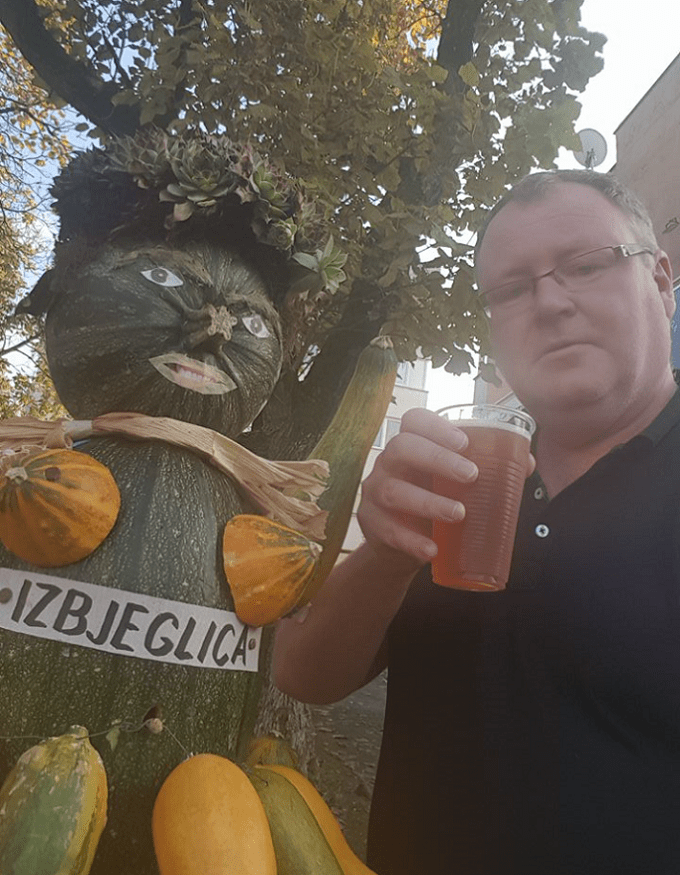
But pumpkin oil is just one use for this very versatile vegetable, whose culinary range is best showcased in the annual pumpkin festival in Ivanic-Grad, known as Bucijada. One of the novelties I tried on my last visit to Bucijada was pumpkin beer, which was surprisingly tasty - almost akin to a wheat beer.
This year's event will take place this weekend, from October 1 to 3, and it really is a great family event, even more so perhaps this year, as the 17th edition of Bucijada coincides with the 7th Toy Festival, thereby giving a double dose of family fun out in the healthy environs of Zagreb county. You can get a snapshot of how Bucijada looks through the eyes of a young visitor in this excellent vlog below.
There is also plenty of gourmet and activity fun for adults at least, not least the opportunity to taste a range of pumpkin products, as well as to get better acquainted with one of the rising stars of the Croatian wine scene - the locally grown grape variety of Skrlet.
Ankica Bester, director of the Ivanić-Grad Tourist Board office, told TCN a little more:
"The novelty of this year's Bucijada is that at the same time the 7th Toy Festival is held at the Zelenjak Sports Park and with SB Naftalan where a rich program has been prepared for the youngest, from performances by First Applause, playrooms, workshops, plays, toy fair and content within the model fortress of Tvrđa Ivanich. At the event itself, the "Educational-presentation center of pumpkin oil" of the association of pumpkin oil producers of Croatia and the City of Ivanic-Grad will be opened next to the Maznica market, where you will be able to see how cold-pressed pumpkin oil is pressed.
"This year's Bucijada is being held in open public areas at several locations in the city center and at the Zelenjak Sports Park in order to adapt to current epidemiological measures."
More details can be found on the Ivanic-Grad Tourist Board website, as well as from the official press release below:
The beginning of October is the right time to visit Ivanic-Grad and the Bučijada exhibition and sales fair.
The seventeenth edition of the largest and most visited tourist, economic and gastronomic event in Croatia this year will be held on October 2 and 3, 2021.
Organized by the Tourist Board of Ivanic-Grad with co-organizers and under the auspices of the City of Ivanic-Grad, Zagreb County, the Tourist Board of Zagreb County and Croatian National Tourist Board, and sponsors: INA d.d., Hrvatske sume d.o.o. and Zagrebacka banka in Ivanic-Grad will host the 17th Bucijada and the 7th Toy Festival.
More than 170 exhibitors from all over Croatia are participating in this year's sales fair, of which 28 are pumpkin seed oil producers, 14 are organic farms and about 50 are family farms.
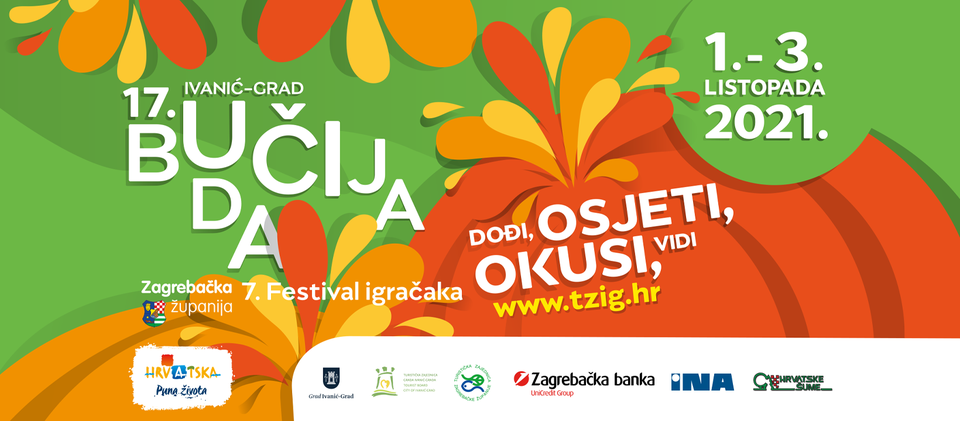
They will offer pumpkins, pumpkin oil, pumpkin products and other eco-ethno products in the city center in several locations. This year as well, the caterers have prepared creative pumpkin menus in their premises, restaurants and rural estates.
Along with pumpkin beer and indigenous skrlet wine, there will be gastro snacks and pumpkins on the town square.
The grand opening of the 17th Bucijada will be held on October 2 (Saturday) 2021 at 11.00 on the stage at Trg V. Nazora in Ivanic-Grad, which will be attended by the mayor of Javor Bojan Les and numerous guests.
After the opening ceremony, at 11.30 am, the "Educational and Presentation Center of Pumpkin Oil" of the Association of Pumpkin Oil Producers of Croatia and the City of Ivanić-Grad will officially open its doors, where you will be able to see how cold-pressed pumpkin oil is pressed.
On Saturday at 12.00 is the opening of the 7th Toy Festival in SP Zelenjak and with SB Naftalan, where a rich program has been prepared for the youngest, from playrooms, workshops, plays and a toy fair, with entertainment from First Applause.
The godmother of the 17th Bucijada, Anita Kajtazi Roth, is coming on Sunday at 10.30.
City institutions and associations have prepared numerous exhibitions, so in the POU you can see the exhibition "150 years of Ivanic-Grad", in the Museum of Ivanic-Grad "Culture and History of Ivanic-Grad", and with the Fire Department Ivanic-Grad exhibitions of mushrooms and small animals.
Several thematic tourist walks were organized, departing from the Visitor Center near the market.
The entertaining part of the program is guaranteed throughout the day, especially with the evening concerts of Petar Graša, Đani Stipaničev and Renata Sabljak. KUDs in traditional Moslavina and Posavina costumes will walk around the city,
and in the Park of Croatian Veterans, a small Pumpkin Village will be arranged with attractive pumpkin decorations, by which this event is recognizable.
The event is held in compliance with all applicable epidemiological measures.
Come, taste, feel, see - 17. Bucijada!
Read more about the unusual food festivals in Croatia in Natural Food Festivals: 25 Things to Know about Croatian Gourmet Goodness.
Dubrovnik-Elafiti Gate: Sustainable Tourism Project Conceived in Brsečine
September 27, 2021- An ecologically sustainable project called Dubrovnik-Elafiti Gate is being developed in Brsečine, including a parking lot with a pier and a boat connection to Lopud and Šipan.
HRTurizam reports that Dubrovnik-Elafiti Gate is a concept of connecting Dubrovnik with the Elafiti islands, especially Lopud and Šipan, with docks for small boats and additional infrastructure in Brsečine.
This concept, presented to the representatives of the City of Dubrovnik by the author and architect Željko Katalinić, is based on the existing idea of activating Brsečine as a link with the Elafiti islands and is complementary to numerous strategic and development documents. Furthermore, the concept is based on the use of renewable energy sources. Therefore, it represents a significant contribution to the relocation and diversification of the tourist offer with numerous benefits for the local population and all citizens of the City of Dubrovnik.
According to the presented concept, the goal is to offer additional parking spaces (120 spaces) at the current rest area, located along the highway, and connect with the new dock for small boats on the newly built road.
All the energy needed to operate this multifunctional project based on eco-technologies would be drawn from self-sustaining sources, including the energy required to charge electric vehicles and small electric ships/ferries with a capacity of 10 to 35 vehicles and up to 150 passengers, which would drive to Elafiti.
In this sense, there are plans to cover all parking spaces with solar panels, and wind energy (windmills) and wave energy obtained through a movable breakwater would be used. In addition, the concept includes the arrangement of a lookout and recycling yard as a representative example of such plants, and kiosks would be set up for the tourist and sales needs of local family farms, an info center for Dubrovnik's Gornja Sela and Elafiti.
For irrigation of green areas and the need for fire protection, rainwater obtained by biological wastewater treatment would be used. The drop-off/on zone by the sea would be arranged as a park of Mediterranean plants.
In nature, the implementation of the Dubrovnik-Elafiti Gate project connects parts of Gornja Sela and the entire city area with the Elafiti. It provides a new basis for the development and exchange of goods and services. In addition, the existing road to Brsečine beach is relieved, which would become a pedestrian zone passable for emergency services, which is not the case so far.
Such a multidimensional and complex project, which is now still at the concept level, will continue to develop to be ready in time to apply for EU funds. Namely, in the new budget period of the European Union, investments from 2021 to 2027 will be focused on five main goals, of which two specific goals are related to the energy transition, renewable energy sources, and the promotion of sustainable multimodal urban mobility, according to City of Dubrovnik.
For more on lifestyle in Croatia, follow TCN's dedicated page.
DN Ambassador Dean Kuchel Hosting Zagreb Meet-Up and Pitch Night at Canopy by Hilton
September 27, 2021 - Outgoing Zagreb Digital Nomad Ambassador Nimrod Dean Kuchel invites you to his final event, a Zagreb Meet-Up and Pitch Night at Canopy by Hilton.
From the moment he landed at Zagreb Airport and even before he took up residence as the Zagreb Digital Nomad Ambassador for September, Israeli Nimrod Dean Kuchel has been working tirelessly to tell the remote work community about the joys of the Croatian capital.
Accepting an invitation to speak at the inaugural Zagreb Digital Nomad Week back in June, Kuchel's engaging presentation on building community was one of the highlights of a thought-provoking week (you can see his presentation below).
The conclusions of an experienced digital nomad who has travelled the world to over 100 countries in 7 years )and with an online DN community of 24,000 people) were encouraging indeed. In a brief interview at the end of that week, he declared that Zagreb ticked all the boxes for digital nomads, and that the only thing missing in Zagreb was more digital nomads.
Just over two months later, Dean was back, this time as the official Zagreb Digital Nomad Ambassador for September. Over welcome drinks, he declared his intention to do as much as he could to unite and grow the community during his time in Zagreb.
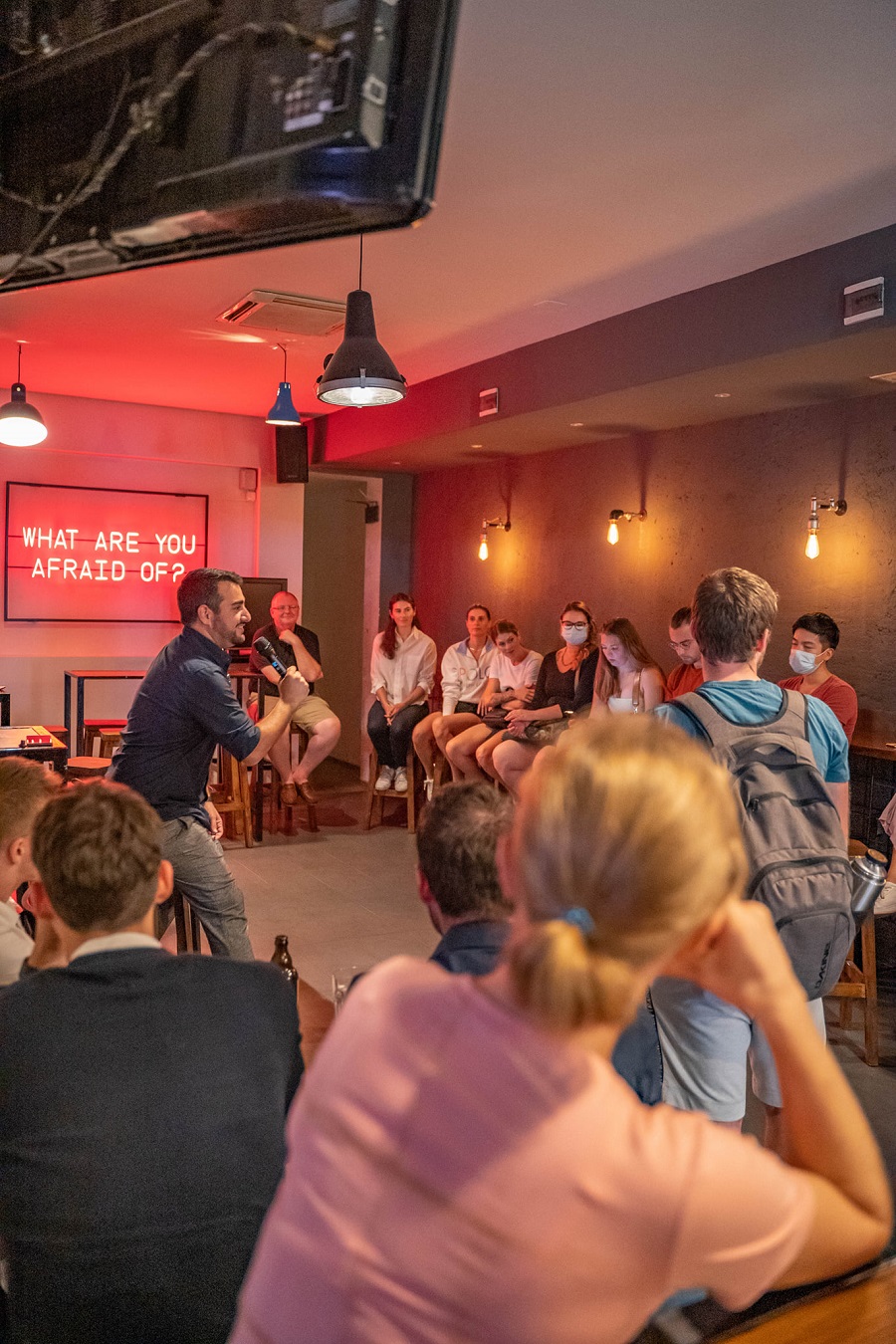
The Digital Nomads Croatia Facebook group hosted an Ask Me Anything (AMA) evening with Dean a couple of weeks, ago at Bustan, which was a well-attended event by locals and digital nomads in the city. Dean has been busy exploring all the co-working spaces in the city, as well as aspects of its social life I will never know about, and is now organising one last event before he hands over the ambassador baton to South African Andrae Smith, who takes up residence at Doma Zagreb Aparthotel on October 1.
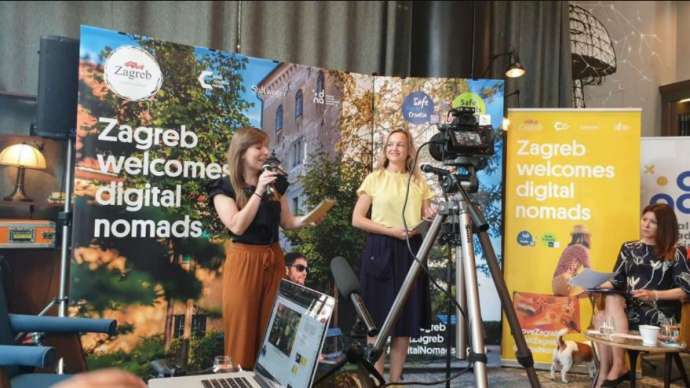
Dean is organising a Zagreb Meet-Up and Pitch Night from 18:00 on Friday, October 1, an opportunity to network and make new friends. The highlight of the evening will be 5 live speakers, sharing travel and digital nomad stories from around the world.
The event will be held where part of Zagreb's digital nomad story began. Canopy by Hilton Zagreb hosted the opening day of Zagreb Digital Nomad Week, and it has since proved to be a hit with visiting nomads. The combination of excellent Internet, services within the hotel, nearby gym and various food options in the Branimir Centre where it is located, has proved to be a winning combination.
The Zagreb Meet-Up and Pitch Night will take place in the hotel's ReUnion restaurant on the ground floor. The Canopy by Hilton Zagreb team has kindly offered a welcome drink to people attending. Food and drink will be available throughout the evening, at your own cost.
You can find more information on the Facebook event page. If you would like to attend, please inform Dean via the event page, so that he can have an idea of numbers. The invitation is open to all - here is Dean's message:
Hi friends,
It was super-awesome to meet you all on our last meet-up!
So a minute before I leave town onto my next adventure, let's meet once again, share a drink, meet new friends, and listen to 5 stories from around the world.
Our mini "Pitch-Night" will include 5 short stories of digital nomads and world travellers, followed by the usual networking event.
The location is the ReUnion restaurant in Canopy by Hilton (Branimir Centre), but please block your calendar - Friday, October 1st, happy-hour time, from 18:00.
Smash that "GOING" button, and I will see you Friday.
Love & WiFi,
Dean
*Want to share your story with the world? send me a message.
This meet-up is with the support of Digital Nomads Croatia Association, Saltwater Nomads, Total Croatia News, and the Zagreb Tourist Board - thank for all your efforts to make Zagreb feel like home to us, digital nomads.
For more news and features on digital numbers in Croatia, follow the dedicated TCN section.
Zagreb Cener 2021: Golden 10th Edition, Applications Open Now!
September 27, 2021 - Marking the 10th anniversary of this famous night marathon, the Zagreb Cener 2021 will be the most epic edition of this race yet. Register to participate and get your legs moving in the City of Zagreb on November 7.
After being cancelled and switched ''to virtual'' due to the pandemic in 2020, the popular night marathon race, Zagreb Cener 2021 is back to normal and will be held on November 7.
This year is the round 10th edition of the race, and so it is only suitable, as Trčanje.hr writes, that the opening of registrations started on September 23 at 10:10 AM. And it's not too late to register for participation yet either.
''Over the last ten years, this race has become popular due to its atmosphere, a straight and fast track suitable for achieving a good record and a route that goes through Zagreb's centre allowing runners to check out nice surroundings during the race. Over the years, Cener was full of sportsmen, recreational runners and average citizens, and many famous people, athletes and racers from abroad have also come and participated,'' writes Trčanje.hr.
This year's special ''Golden edition'' of the race will include a ten-kilometre race. Under the motto of ''Heads up'' to honour the struggles of 2020, the starting line, for the first time ever, will be at Ban Jelačić square, the central square of Zagreb.
''Road traffic and trams will be completely stopped from 19:00 to 20:15,'' says the official Zagreb Cener 2021 website. This will ensure a safe race that will be organised in two laps.
The first lap goes through following streets: Ban Jelačić Square – Jurišićeva – Palmotićeva – Boškovićeva – Držislavova – Victims of Fascism Square (with running around the square itself implied) – Račkoga – Jurišićeva – Ban Jelačić Square – Ilica – Krajiška – Gjure Deželića – Republic of Croatia Square– Masarykova– Teslina– Nikola Šubić Zrinski Square – Amruševa – Palmotićeva– Jurišićeva – Ban Jelačić Square.
The second lap goes through: Ban Jelačić Square – Ilica – Krajiška – Gjure Deželića – Republic of Croatia Square – Masarykova– Teslina– Nikola Šubić Zrinski Square kolnik) – Amruševa – Palmotićeva– Jurišićeva – Ban Jelačić Square.
The race has had its male (Mitja Krevs, 00:31:17) and female (Matea Parlov, 00:34:55) records set back in 2018, and those who manage to beat this and set a new record will be rewarded with a 1,500-kuna-worth card to spend at the Hervis sports store.
Additionally, this year's race has a team racing option.
''After the standard registrations, ten or more people can register as a team one week before the race begins. By their selected name, the ten fastest from each registered group will be put in competition for the champion title of the team race that will take home a special trophy,'' explains Trčanje.hr“.
With the pandemic situation becoming much better but still requiring caution, the organisers have warned that covid certificates may be required (depending on the number of infections at that time), and epidemiological measures will all have to be respected. In the event of bad weather or a worsened epidemiological picture, the race may be postponed to a later date.
Due to the limited number of participants that can register due to the ongoing situation with the spread of coronavirus in Croatia, the race also still has a virtual option.
''Quite simply, run for ten kilometres and send us a screenshot of the app you used to measure your time and the length of your run,'' explained Zagreb Cener's official website.
The virtual race will last from November 7-14, and all the times at ten kilometres in length will qualify for the virtual champion title.
Whether you choose to go for a real-life or virtual event, registration fees must be paid before your application gets accepted. For the regular race, the price is 180 kuna, while the virtual race requires a 130 kuna fee. Pay the fee, get your welcome package, and then let your legs do the rest.
Learn more about sport in Croatia in our TC guide.
For more about marathons in Croatia, follow TCN's dedicated page.
Croatian National Security Report 2021: Stable Democracy, Neigbours Having Problems
September 27, 2021 - The Croatian National Security Report 2021 says Croatia is a stable democracy, but some issues which need to have an eye kept on them have been revealed.
Like any country which cares about national security, Croatia has its own intelligence agency. Croatia's Security and Intelligence Agency (acronym, or in spy terms, code name SOA) collects and analyses information in an attempt to detect and prevent the activities of individuals or groups that threaten the independence, integrity, and sovereignty of the Republic of Croatia, and/or those who aim at violently overthrowing constitutional order. Additionally, let's suppose you're in Croatia and you try threatening human rights and basic freedoms or want to endanger the fundaments of the economic system of the Republic of Croatia, in that case, you will also make it to the list of this organization.
''SOA also collects and analyses political, economic, scientific-technological and security-related information concerning foreign countries, organisations, political and economic alliances, groups and persons and other information relevant to national security,'' explains SOA's public website.
As Slobodna Dalmacija writes, SOA has so far published seven reports assessing the threats to Croatia's well being previous years. The latest reports, as Slobodna Dalmacija writes, rates Croatia as a safe and stable democracy. However, the pandemic boosted the rise of extremism and radicalism in the country, namely due to disinformation and conspiracy theories in the European and national response to this unprecedented public health crisis.
The terrorist threat in Croatia is low but not completely out of the equation.
As TCN wrote back in October 2020, a policeman was wounded on St Mark's square (Markov trg) in Zagreb (which is home to both the parliament and governmental building) by 20-year-old Danijel Bezuk, who, shortly after the incident and while on the run, took his own life.
''SOA states that the attack had the features of a terrorist assault from the extreme right spectrum and the gathered data suggest a psychological disorder of someone with a disassociative, bipolar personality. However, no type of extremism has significant basis nor public support and therefore no potential for endangering national security,'' writes Slobodna Dalmacija.
Nonetheless, more serious threats have been identified and explained.
When it comes to internal threats, corruption should come as no surprise. Criminal organisations and individuals, SOA warns, try to illegally affect public representatives.
''The attempts of corruptive influence on political, legal, economic and other processes and on public interest decision making processes are particularly worrying,'' says Slobodna Dalmacija in following SOA's report. Looking at solely external threats, the tensions between EU and Russia didn't bypass Croatia as SOA confirmed 12 state-sponsored cybernetic attacks in Croatia which came with a Russian signature.
Additionally, tensions in neighbouring countries need to be observed closely from the perspective of Croatian national security, warns SOA.
''The report states that Greater Serbian extremism is still present in certain neighbouring countries, and this is evident in their denying Croatia and neighbouring countries their territorial integrity,'' Slobodna Dalmacija reports.
Following previous TCN writing, this is clearly a reference to the tensions in Montenegro as well as Serbian President Aleksandar Vučić's calls on ethnic Serbs in Croatia to raise Serbian banners in the country. When it comes to Bosnia and Herzegovina, radical Islam, which also questions the integrity and values of both democracy and territorial borders, is also a reason for serious concern.
If you don't look for trouble, but trouble always ends up finding you, you can learn more about the emergency services that can help you in Croatia in our TC guide.
For more about security in Croatia, follow TCN's dedicated page.


